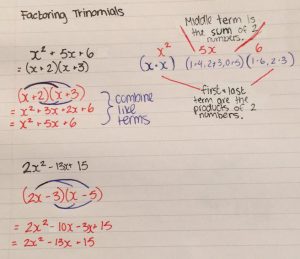Some things things I think I should have done better are definitely the blog posts.. I think doing those on time would have been probably better for grading but at the same time doing everything towards the end I think helped me study for my final.
Another thing I should have done better was my time management as I have little free time as it is, I used my free time for my English homework and neglected my math cause my English teacher handed out loads of homework like is a university course.
Some critical units were definitely the last unit we did and probably exponents as I found exponents were a harder unit and often come up in other units. Also saying I thought trig and the numbers unit were probably the easiest.
Another thing I wish I did better was my studying for tests I didn’t really think to much or prepare myself but I wish I had studied more. I didn’t as many questions but I wish I asked more questions when I found something difficult cause that may have helped my in the future.
And I wish I had more peers in my class so I could have studied with friends and asked questions. But definitely asking a teacher for specific questions would be a good thing to do. I tend to work better with people I’m comfortable with and on my own isolating myself from everyone.
 decreases from right to left. (M) is the variable for slope and rise is (X) and run is (Y)
decreases from right to left. (M) is the variable for slope and rise is (X) and run is (Y)
 finding the Y intercept it is nearly the same thing except you replace X with 0 in order to isolate Y to find what it is equal to.
finding the Y intercept it is nearly the same thing except you replace X with 0 in order to isolate Y to find what it is equal to. I chose to go over the distributive property because I forgot about this unit when going over the review package as well as the numbers unit. In distributive property you multiply the constant by the contents inside the brackets. Make sure your work is neat and tidy so you don’t get lost in bigger equations. I like to colour coordinate my terms so Its easier for me to decipher which terms I can group and which I cannot.
I chose to go over the distributive property because I forgot about this unit when going over the review package as well as the numbers unit. In distributive property you multiply the constant by the contents inside the brackets. Make sure your work is neat and tidy so you don’t get lost in bigger equations. I like to colour coordinate my terms so Its easier for me to decipher which terms I can group and which I cannot.
 The first thing you want to do when removing the GCF in a trinomial is find all the factors of each number. Each number that has similar factors you can begin to remove, you want to place the factor you chose and move it outside of the brackets as well as dividing that number out of the trinomial, the number you get from dividing the factor goes inside the brackets. This makes factoring much easier. I chose simple examples which in my first example my numbers were 5, 15, and 10 and the factor I removed and divided by was 5x because in the trinomial each number had (X) in it. In my second example I had numbers 6, 9, and 18 and I removed 3 and divided each number by 3.
The first thing you want to do when removing the GCF in a trinomial is find all the factors of each number. Each number that has similar factors you can begin to remove, you want to place the factor you chose and move it outside of the brackets as well as dividing that number out of the trinomial, the number you get from dividing the factor goes inside the brackets. This makes factoring much easier. I chose simple examples which in my first example my numbers were 5, 15, and 10 and the factor I removed and divided by was 5x because in the trinomial each number had (X) in it. In my second example I had numbers 6, 9, and 18 and I removed 3 and divided each number by 3.
 In this lesson of polynomials we learned how to FOIL. Its a method used when multiplying using the distributive property that is very easy and the way you write it out makes it very easy to understand when looking at it rather than trying to do it in your head.
In this lesson of polynomials we learned how to FOIL. Its a method used when multiplying using the distributive property that is very easy and the way you write it out makes it very easy to understand when looking at it rather than trying to do it in your head.
